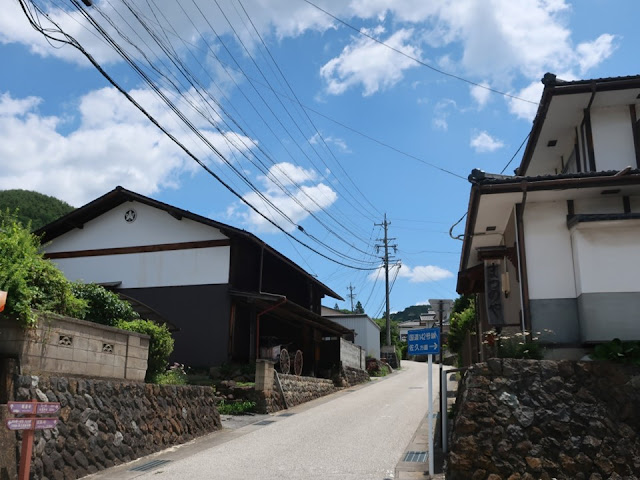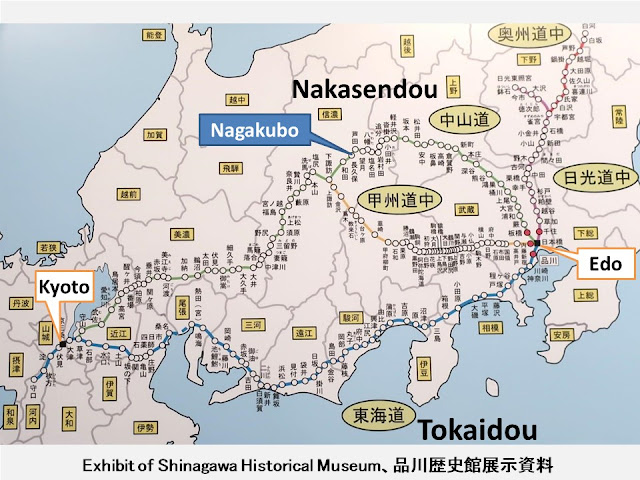Nagakubo post-town in Nagano prefecture of central Japan was developed when Nakasendou highway was constructed; the highway linked Edo (old name of Tokyo) and Kyoto.
The post-town is between two difficult
passes, so many travelers stayed there and went over the pass next day. However,
the town changed to a farming village after the motorway and the railway were
constructed. Both new ways were built outside the town, thus the old town
scenery remains. Three houses are opened to the public. I wonder why
Nagakubo isn’t a busy tourist spot.
長野県の長久保宿は、中山道の開設に伴って作られた集落です。難所の和田峠(1531m)と笠取峠(900m)の間にあり、多くの旅人が宿泊しました。しかし、車道と鉄道が建設されると農村へと姿を変えていきました。車道や鉄道が街中を通らなかったおかげで、本陣をはじめ街がよく残っていて、3軒が公開されています。人気観光地になっていないのが不思議なぐらいです。
The old highway is an upslope and leads to Kasatori pass (900m). The house on the left was probably built before 1731; it was a brewer “Narukamaya”, but it is a private residence at present. It has udatsu firewalls at both sides, which is a symbol of a wealthy family.
宿場を通る旧中山道は、笠取峠へ向けて登っていきます。左は、醸造業を営んでいた釜鳴屋さん、今は個人住宅です。1731年以前に建てられたようです。両端の卯建が立派です。
The building above was an inn for daimyo lords, “Honjin”. It has a dedicated room for the lords, which has a raised floor. It is said that it is the oldest existing Honjin of Nakasendou highway. The daughter of the fourth-generation family head got married with Sanada Yukimura (1567-1615), who was one of most popular warlords.
こちらは旧本陣です。上段の間も残っていて、中山道の現存最古の本陣といわれています。こちらも個人住宅。四代目当主の娘は、なんと真田幸村に嫁ぎました。名家ですね。
Nagakubo history museum “Hamaya”、長久保宿歴史資料館「一福処濱屋(いっぷくどころ・はまや)」
If you go up a bit from Honjin, you’ll find “Hamaya”. It had been built as an inn in the late 19th century, however, it was not operated because of traffic reduction. It was donated to the town in 2000 and was opened to the public as a museum and a lounge.
本陣から少しだけ坂を登ったところにあります。明治初期に旅籠として建てられましたが、中山道の交通量が減ったため開業しませんでした。2000年に長和町に寄付され、資料館として公開されています。
There is a large single swing door at the entrance; it has a small door on it. The small one was probably used at night.
玄関は巨大片開き扉。夜間用と思われる小さな扉も付けられています。
There are large wooden floor rooms inside.
It is the lounge.
内側には広い板の間があります。一服どころですね。
Chic furniture and utensils are displayed at the 1st floor.
一階ではすてきな民具が展示されています。
The 2nd floor is an exhibition room. Not only trip in old days but “Honjin” “Narukamaya” “Sanada clan” are explained. The exhibits are preserved in good condition.
二階は展示室として利用され、旅だけでなく、本陣や釜鳴屋さん、真田家に関するコーナーもあります。保存状態が良い品が展示されています。
The photo section is named “Changing of Nagakubo post-town”. The title of the photo at lower left is “Sakura cherry-blossom viewing at Mt. Tenjin”. It’s a fun time!
昔の長久保宿。「長久保宿の移ろい」というタイトルで紹介されています。左下は「天神山での花見」、いいですねえ。
Tengu (legendary powerful beings) lead the procession of lion dance in the autumn festival, which has been held since the Edo period (1603~1868).
秋に行われる大山獅子、江戸時代から続く伝統の祭りです。高下駄を履いた天狗が行列を先導します。
On New Year's Eve, children carried masks for a lion dance and paraded around the town. Following 1st and 2nd of January, they put the mask on, visited houses, and prayed for sound health and safe of the family. It is nice that it was performed by children only; older children lead the group.
こちらは大晦日の子供獅子。大八車に獅子を載せ、町を練り歩き、道祖神へ行きました。元日と二日は、獅子をかぶって、家々を回り、無病息災、家内安全を祈りました。高学年をリーダーに子供だけで催行するのがいいですね。
Ex inn “Marukiya”、元旅籠「まるきや」
It is opposite side of the museum “Hamaya”. Many stones are put on the wooden roof because it wasn’t fixed by nails.
資料館の向かいにあります。屋根に置き石が多いのは、釘を使わずに板屋根を葺くためです。
We can rent the room for a meeting and so on.
部屋を借りて利用することもできます。
The highway in front of the building is straight.
玄関先から見るとまっすぐに街道が伸びています。
Ex farmer’s house “Goichian”、元農家「吾一庵」
The highway on the other side leads to Kasatori pass. The “Goichian” on the left side is also opened to the public. The master owned a horse; it’s ordinary as a farmer back then.
反対側は笠取峠への坂道です。左側が吾一庵で、見学可能な民家です。かつては馬を飼っていて、一階は、農家型の「土間+田の字/四部屋」の間取りです。
There are four tatami mat rooms in the 1st floor.
田の字の一間は12畳あり、広々としています。
There is no finishing on the sliding door on the right. The papers during writing practices are recycled as material of the base of the door. They (children?) wrote very well.
囲炉裏がある間の障子は、裏紙がそのまま残されています。上手な習字ですね。
Many old documents, utensils and masks are exhibit on the 2nd floor.
二階には古文書や民具に能面? 大量に展示されています。
Visited in June, 2023
Reference
site: https://www.nagawa.info/facility-spot/2047/
(in Japanese), accessed in December, 2023
Previous post (museums of the nearby post-town): Museum of Mochizuki History、望月歴史民俗資料館
Next post (part2
of this article): Nagakubo post-town and museums (2/2)、長久保宿と資料館 (part2)


















Comments
Post a Comment